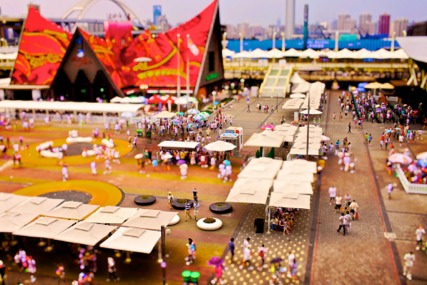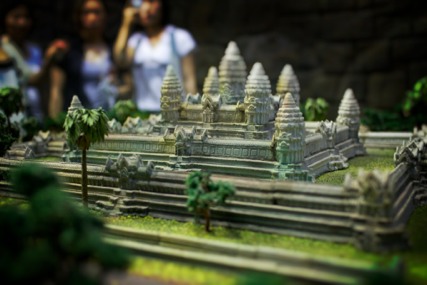Bringing together 190 countries, and more than 50 organisations and corporations that have a say in our urban futures, Shanghai 2010 offers an intriguing representation of the world as it is today. A unique forum, the Expo is a stage for many of the worlds most important players to communicate to a huge audience their ideas about the future, about urban sustainability and about what makes for a better life. With the host city interpreting Better City, Better Life in terms of harmony, multi-million dollar pavilions proclaim and entice harmonies between man and man, man and nature, past and future, and some of the ways in which these might be created or maintained. In light of the breakdown of the 2009 Copenhagen climate change talks, the Expo thus represents an important alternative for much needed cross-cultural dialogues and international collaborations.

Shanghai 2010 is the latest event in a 160 year long tradition of World's Fairs and Universal Expositions. Renowned for their elaborate displays of technology and culture, expos have long been unique environments within which a sense of collective identity is evoked by the coming together of nations, as they are at once held in a spirit of competition for months on end. No exception, Shanghai is encapsulated by a moment in history defined by China's rise as a global superpower, and by the multiple challenges associated with sustaining life on an ever warming planet. But the Expo has also been planned and hosted at a moment in history where expressions like 'The War on Terror', 'Clash of Civilisations' and 'Axis of Evil' form part of the parlance of globalisation. Yet in the microcosm of the world that is the expo, such concerns are rendered invisible in favour of a language of 'harmony' and 'cross-cultural dialogue'.

Straddling the Huangpu river, the Shanghai expo site divides the world, with all its countries, cities, institutions and corporations, into five zones: Asia; Southeast Asia and Oceania; Africa, Americas and Europe; Corporate; and Urban Best Practice. As with previous World's Fairs, the primary audience is a domestic one. Given that around 98% of visitors are Chinese, this event takes on particular significance as the vast majority of these have yet to travel overseas. 'Seeing the world' happens via foot, bus, electric shuttle or via a new metro line that passes under the river. The language of tourism pervades the expo experience. Chinese media have been recommending 'must see' countries on a near daily basis, and a visit is not complete without the purchase of an expo 'souvenir'. The 'Expo Passport' - which can be stamped on departure of pavilions has also become the event's unrivalled iconic collectable. Sold empty for US$2, passports with a complete collection of stamps have been sold in online auctions for more than US$1,000. In hosting this World Fair the Chinese government has created a unique event of civic education. In the way the 2008 Olympics facilitated the world to learn about China, Shanghai Expo is enabling China to learn about the world.


The format and layout of the expo render this world visible and consumable in peculiar and interesting ways. Whether they are housed in separate pavilions or clustered together in the same building, the idea of nations as discrete, neatly bounded entities is normalised in the popular imagination. In a micro-geography of country as architecture, nation-states sit side by side, in neatly planned rows or face inwards creating spaces reminiscent of the public squares of historic European cities. There are no border disputes, trans-national conflicts or historical grudges as the global tensions of today are expunged in a geography of apolitical harmony. Indeed in all its cultural, ethnic and religious complexity, the world is presented as benignly cosmopolitan, where countries present themselves as unconditionally hospitable.

Particularly important is the ways in which the pavilions themselves afford such notions of hospitality. In a world of visa free expo travel, the welcome by all, to all is unconditional. Across the site, countries employ multi-lingual 'cultural ambassadors' to help ensure their 'guests' have an enjoyable experience and leave with good memories. What's remarkable about the universality of this welcome, is that it takes place at a time when many nation-states are deeply anxious about the rapid growth in international migration and the challenges of policing borders. The free stamping of expo passports lies in distinct contrast to the complex array of entry restrictions and conditions many countries would impose on their own soil to these same visitors.

Other complexities are dissolved away at the expo, in large part due to the logistics of visitor management. The sheer scale of the event, both in terms of the number of attractions and daily visitors, means pavilions designers are (wisely) reluctant to offer much, if any, detail about the complexities inherent to creating better cities, better lives. And as the site as a whole scales down planetary geographies, table top models allow pavilion visitors to travel in time. Neon landscapes of wind-turbines and oil rigs evoke a better future of abundant energy for all. While idyllic pasts and simpler times are captured in replica models of villages, historic cities and the archaeological remains of lost civilisations. Seen together, these models efface and conceal with their visions of utopia and nostalgia.

Geographic anomalies infuse the expo experience. New Zealand sits in between Malaysia and Cambodia in the Asia square, but not in the Asia zone; whereas across in Zone A (Asia), Morocco, UAE and Saudi Arabia all lie in close proximity to India. Of note is how the site's zoning reconfigures the world with China at its centre. With a pavilion three times the height of all others, China stands as an ever visible landmark around which visitors travel to other countries. The observant visitor cannot fail to notice the symbolism of placing the smaller pavilions of Taiwan, Hong Kong and Macau close by, quite literally in the shadow of the PRC. In both the expo's architecture and layout, visitors are also presented with tangible markers for assessing the strength and status of the world's nations, with some country's creating bespoke designs and the less rich and powerful congregated in 'joint pavilions'. The central location of the Chinese pavilion, together with the positioning of the USA and Japan at the far ends of the site, also offers visitors an interesting glimpse into the geographies of a new world order, as seen by the host country.

A visit to Expo means coping with an onslaught of messages about sustainable cities, the beauty of nations, and the promise of technologically rich futures. But hidden among the crowds, queues and giant LED displays is something much more intriguing: a mega event that, in its design, declarations of cosmopolitanism and culture of hospitality, offers us a glimpse into the state of the world as it is today. It is a prism through which though only certain features are rendered sharp, as much of the mess and complexity of our contemporary global moment fades away into the background.

A photographic essay that accompanies this piece is available at: http://timwinter.carbonmade.com
Tim Winter is Senior Research Fellow at the Centre for Cultural Research, University of Western Sydney. Email timwinter@me.com.














